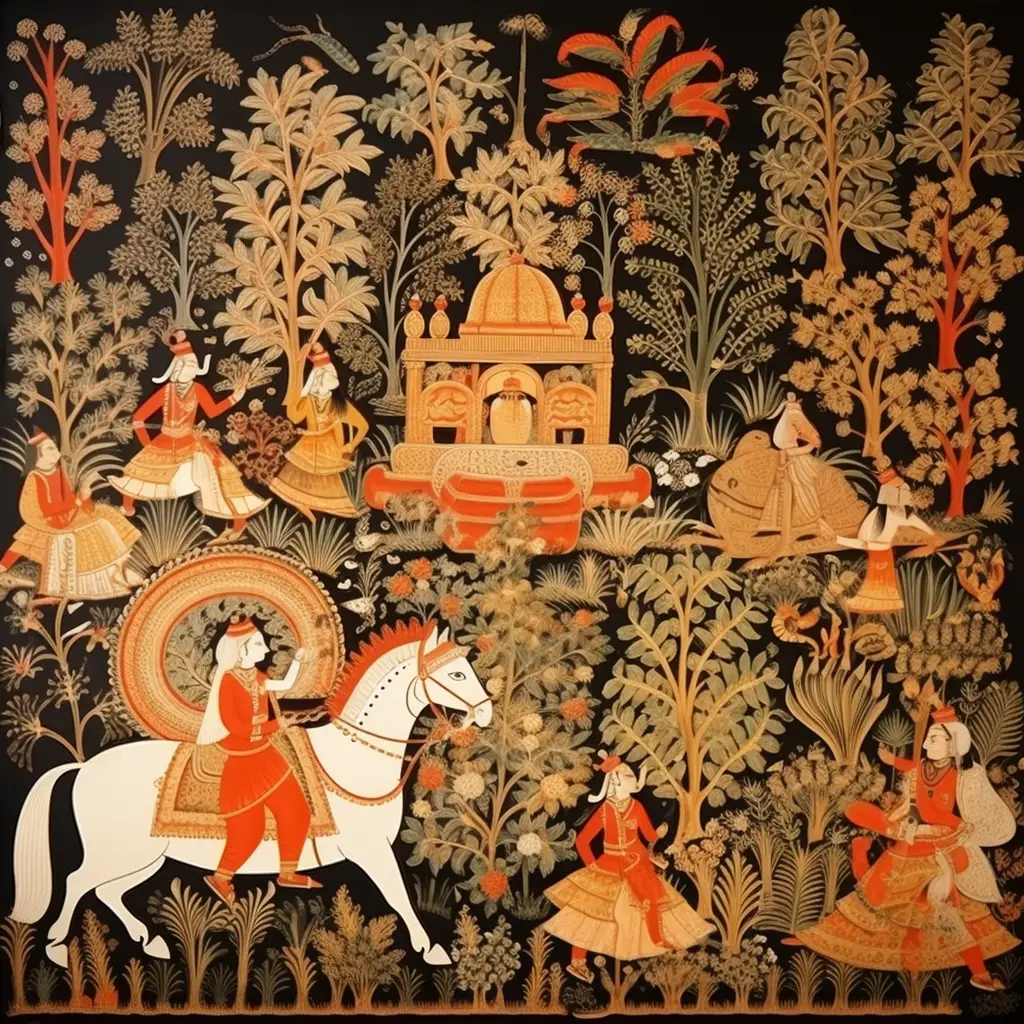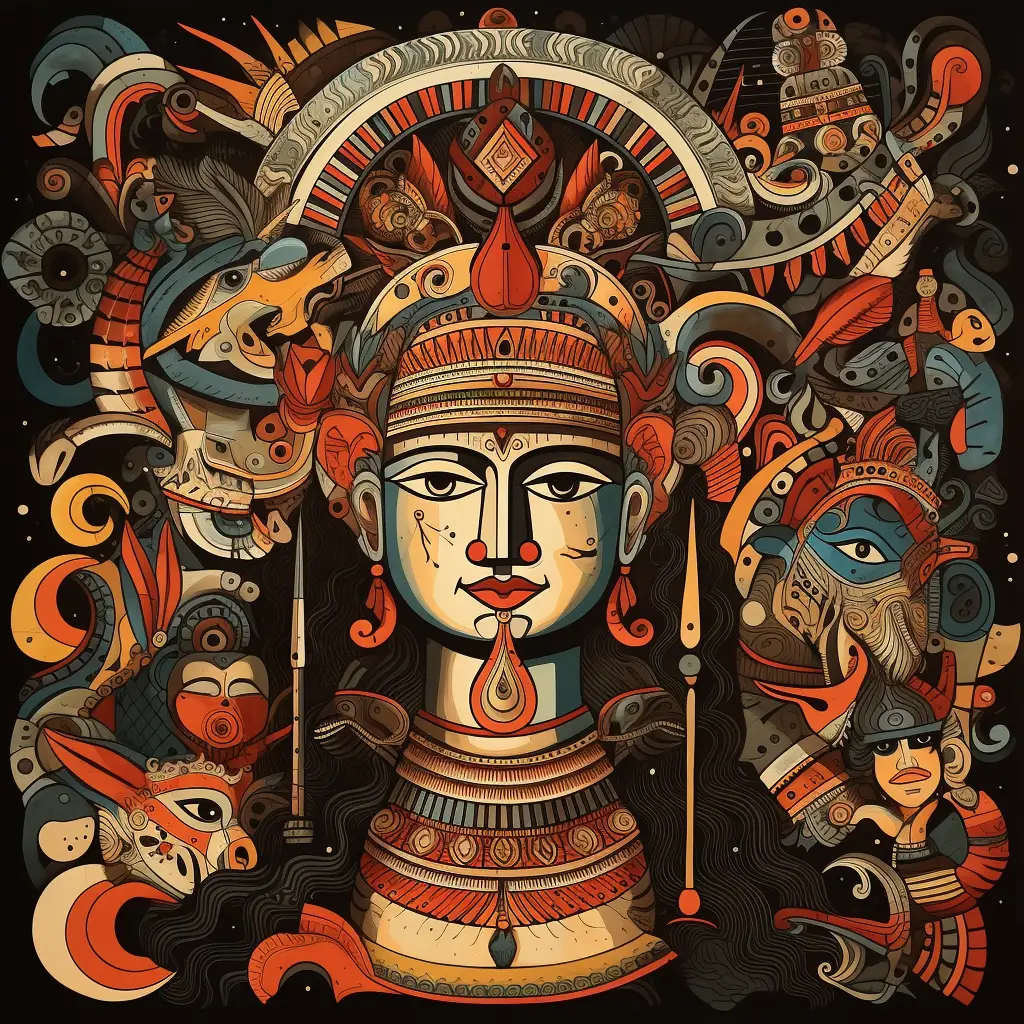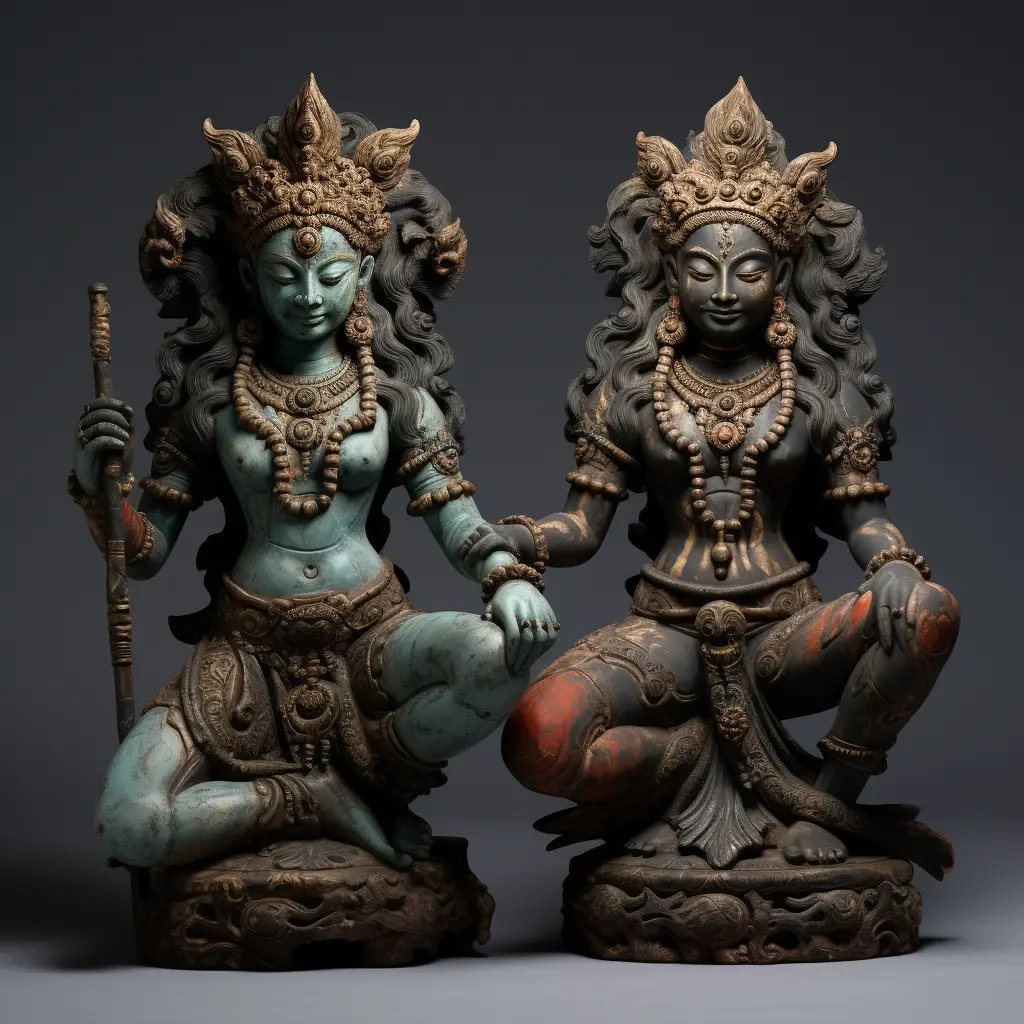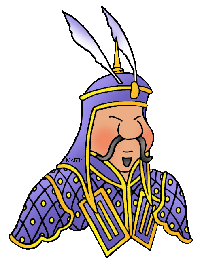Ancient Indian Art
Ancient Indian art showcases a rich and diverse cultural heritage. It encompasses various forms such as sculpture, painting, and architecture. The art reflects religious beliefs, social structures, and historical events of that time. It is characterized by intricate details, vibrant colors, and spiritual symbolism.
Ancient Indian art continues to inspire and influence contemporary artists worldwide, serving as a testament to the artistic prowess and creativity of the civilization.

Ancient Indian Art Facts for Kids
- Ancient Indian art dates back to 3000 BC.
- It included paintings, sculptures, and architecture.
- Cave paintings are found at sites like Ajanta.
- Buddhist themes were prominent in early art.
- Temples often featured sculptures of gods.
- The Ashoka Pillar shows early Indian sculpture.
- Indian miniature painting style was very detailed.
- Mudras (hand gestures) were significant in art.
- Terracotta was widely used for making figurines.
- Folk art forms, like Rangoli, were popular.
Indus Valley Civilization Art
The Indus Valley Civilization, flourishing around 2500 BC in the areas that are now Pakistan and northwest India, was renowned for its significant contributions to ancient Indian art, a fact that would surely intrigue children. This civilization was marked by the inhabitants’ proficiency in various forms of art and crafts, including but not limited to sculpture, seal carving, pottery, and jewelry making.
Their artistry was epitomized by works such as the Dancing Girl statue, a mere 4.1 inches tall bronze piece, which underscored their exceptional attention to detail and craftsmanship. The pottery from this period was often adorned with captivating geometric and animal designs, while their seals were typically carved from soapstone, bearing detailed depictions of animals and humanoid figures.
Their jewelry, crafted from gold, silver, and precious stones, demonstrated a high degree of sophistication. The artifacts from the Indus Valley Civilization provide us with a unique perspective into their advanced society and rich cultural heritage.
Buddhist Art in India
Ancient Indian art for children commonly encompasses intriguing details about Buddhist Art, which originated in the 3rd century BCE from the teachings of Siddhartha Gautama, known as the Buddha. This art form, known for its exquisite statues, paintings, and architectural designs, primarily aimed to venerate Buddha and his teachings.
The Giant Buddha statue in Sarnath, a renowned piece, presents Buddha teaching his disciples while seated. Furthermore, the intricate designs on the dome-shaped stupas, often housing Buddha’s relics, narrate various episodes from his life. These designs served an educational purpose, enlightening followers about Buddha’s teachings.
Therefore, ancient Indian art, particularly Buddhist Art, served not only as an expressive medium but also as an instrumental tool for propagating Buddhism throughout the nation.
Hindu Temple Architecture
Exploring ancient Indian art, particularly Hindu Temple Architecture, can captivate children’s interest. These temples are more than just places of worship; they serve as grand canvases showcasing various art forms.
The narratives of Hindu mythology, representing gods, goddesses, and scenes from epic tales like the Mahabharata and Ramayana, are intricately carved into the walls, pillars, and ceilings. Additionally, these temples embody the sacred geometric design of ‘Vastu Shastra,’ aligning the structure with cosmic energies.
It’s this distinctive fusion of art, storytelling, and spiritual science that makes Hindu Temple Architecture a mesmerizing aspect of ancient Indian art.
Indian Frescoes
Ancient Indian art, notably the frescoes originating from the historical cities of Ajanta and Ellora dating back to 1500 BCE, occupies a distinguished position in global art history.
These frescoes, a form of mural painting executed on wet lime plaster allowing the paint to integrate with the wall, exhibit an extraordinary fusion of religious, mythological, and royal themes. The vibrant colors, complex designs, and exquisite craftsmanship of these frescoes, created by unidentified artists, exemplify the richness of ancient Indian art.
Recognized as masterpieces and an integral part of India’s cultural heritage, the Ajanta frescoes provide an intriguing insight into ancient Indian society, beliefs, and customs to young learners.
Gandhara Art

Originating around 2,300 years ago, Gandhara Art is a fascinating segment of ancient Indian art history that may captivate children. This art form primarily flourished in the Gandhara region, which is now part of modern-day Pakistan and Afghanistan.
Gandhara Art is remarkable for its heavy Greek and Roman influences, a testament to the region’s historical connections with these empires. This blending of styles is particularly evident in the distinct Buddha sculptures, the most celebrated works of Gandhara Art. Breaking away from traditional Indian portrayals, these sculptures depicted Buddha with realistic human features, curly hair, and attired in clothing akin to Greek and Roman figures.
Additionally, Gandhara Art intricately captured architectural structures and narratives from Buddha’s life, offering an engaging mode for children to explore both art history and ancient cultural exchanges.
Mauryan Pillars and Sculpture
The Mauryan Empire, a prominent entity in ancient India from 322 to 185 BCE, was notably acclaimed for its substantial contributions to art, particularly in pillars and sculptures. A prime example of their artistry is the Ashoka Pillar, crafted under the rule of Emperor Ashoka, which was not only ornamental but also served as a medium to communicate the emperor’s messages and decrees through inscriptions.
These pillars, carved from a single piece of stone, frequently bore sculptures of lions or bulls, signifying strength and tranquility. In addition, the Mauryan Empire produced an array of exquisite sculptures, often representing humans and animals, with their art so intricate that it could accurately depict the pleats of clothes and the fine details of jewelry.
This era represented a remarkable progression in Indian art, manifesting the outstanding craftsmanship of Mauryan artists.
Gupta Art
Ancient India’s Gupta Art, flourishing from the 4th to 6th century AD, is often seen as the zenith of Indian artistic expression and can particularly captivate children with a passion for history and art. The Gupta age is marked by a surge in sculpture, painting, and architecture, all of which exhibit a distinctive balance and harmony.
This period gifted us with exquisite examples of Buddhist, Hindu, and Jain art, with the Ajanta Caves’ stunning murals and sculptures showcasing Buddha’s life being one of the most renowned. In addition to this, Gupta artists demonstrated exceptional skill in metalwork, crafting intricate statues of deities using the lost-wax casting technique.
By studying Gupta Art, children can gain a deeper appreciation for India’s rich cultural heritage and the historical context that surrounds art.
Indian Miniature Painting
Indian Miniature Painting, an integral component of ancient Indian art, is something that children may find enthralling due to their tiny yet intricate detail. These paintings were primarily developed for book illustrations or private collections, originating around the 10th century and reaching their zenith during the Mughal Empire between the 16th to 19th centuries.
While each geographical area of India evolved its own distinctive style, they all collectively exhibit vibrant colors, intricate designs, and depictions of various themes such as nature, Hindu deities, and scenes from epic sagas like the Mahabharata and Ramayana. Despite their diminutive size, these paintings narrate grand tales and demonstrate the remarkable artistic abilities of ancient Indian artisans.
Indian Rock-Cut Architecture
Ancient Indian Art for children is an intriguing exploration of captivating facts, particularly about Indian Rock-Cut Architecture. This distinctive architectural style, prevalent from the 3rd Century BCE to the 7th Century CE, involved the remarkable feat of carving entire structures such as temples, monasteries, and palaces straight into natural rock surfaces.
The technique is an impressive display of the extraordinary craftsmanship of ancient Indian artists and architects, visible across the length and breadth of India. The Ajanta and Ellora Caves are the most renowned examples of this form of construction, housing exquisite sculptures and paintings narrating tales from Indian mythology.
This rock-cut architecture indeed stands as a grand testament to the extraordinary creativity, perseverance, and skill of ancient Indian artisans.
Yaksha/Yakshi Statues

Ancient Indian art boasts a rich history, one of the most intriguing elements of which is the Yaksha/Yakshi statues. These figures, depicted as robust and healthy, symbolized abundance and prosperity and were worshipped as nature spirits by ancient Indians.
Crafted from stone and occasionally metal, these statues are among the earliest known monumental sculptures from India. The Mauryan period, spanning from 322-185 BC, saw the creation of numerous monumental Yaksha/Yakshi statues, often illustrated as guardians of earthly treasures and soil wealth. Of particular interest to children is the belief that Yakshas and Yakshis were revered protectors, celebrated for their ability to bring good fortune and prosperity.
Do you like mysteries and secret codes?
Then you might be interested in the seals that have survived from the early Indus Valley civilization. These seals were most likely used in trade, as they have been found in the ruins of other civilizations far from the Indus Valley. They are small rectangular stones with images carved into them.
The images are of animals such as antelope, elephants, rhinoceros, tigers, and water buffalo. There are also images of humans, and some of them even have been written. The writing is in pictographs, which are pictures that represent sounds. The writing on the seals has yet to be decoded. Perhaps you could be the one to find out their meaning!
Marvels of Indian Art: Sculptures and Symbols of Power and Faith
Along with the seals, many small metal and clay sculptures of animals and people have been found, and some large sculptures, including large bronze statues of a bull with a chariot driver, a buffalo, and rhinoceros, and an elephant.
This area is the home of several of the world’s major religions, so it’s not surprising that most of India’s art is centered on religion. Around 300-200 B.C., the Buddhists began to erect large stone pillars at important places. These pillars were often topped with a figure of a lion. The lion was a symbol of power for Indian rulers. Other pillars had figures such as lotus flowers, bulls, and elephants.
Mystical Wonders: Gods, Spirits, and Sacred Burial Mounds in Ancient India
Many large stone figures were made of the traditional village gods, called yakshas and yakshis, which were male and female nature spirits.
Later, the Buddhists began to make large burial mounds called stupas. These were shaped like Buddha’s body, which they believed was perfectly proportioned. (If you’ve seen pictures of the Buddha, you know he is often shown as being quite round). Stupas were originally burial places for holy people.
One legend says that Emporer Ashoka took the relics from Buddha’s grave and distributed them all around the country, and thousands of stupas were built to protect them. One of the most important stupas is the one at Sanchi, a small Indian village. It is a place of pilgrimage (a trip to visit a holy place) because it is believed to cover some of Buddha’s remains.
The Compassionate Buddha: From Stone Carvings to Paintings of Beauty
As Buddhism spread, Buddha’s followers began to make images of him in human form, so that others might learn about him. At first, he was shown with a very stern look, but later, he was shown to have gentle eyes looking downward, and a soft smile.
Remember the large temples carved into the mountains that you read about in the architecture section? These temples contained not only carvings but paintings as well. The paintings were mainly of people and animals. They were very realistic images, with color and shading that made them look natural, and outlined in a way that made them seem to stand out from the wall.
Mythical Gods and Colorful Manuscripts: Exploring the Artistic Treasures of India
Hindus also made carvings of their gods. These were shaped like humans, but often with many arms or heads, to show that they could take many different forms. In northern India, their images were carved into rocks. In southern India, they were made of bronze. When Islamic rulers took over the northern part, they forbid the worship of carved figures shaped like humans, so the carving of these figures decreased.
From around the year 1000, the artists of India began to illustrate manuscripts. The “paper” was made of palm leaves, and the illustrations were in bold, bright colors, to show the events happening in the book. When the Mogul empire ruled India (from the 1500s to the 1850s), Islamic artists were hired to train Indian artists in painting. The books that were now illustrated were not religious books, but myths or stories of kings and heroes. And artists were encouraged to observe and try to capture the wonder of the world around them.
From mysterious ancient seals to brightly illustrated manuscripts, the art of India spans many years with many different styles. Religion is the main focus of art, with personal expression always finding a way to shine through the artist.


